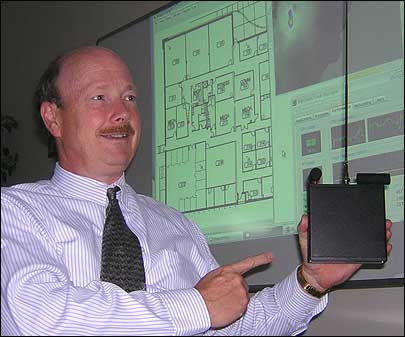Aug 09, 2005Q-Track, a startup in Huntsville, Ala., says it has developed a low-frequency real time locating system (RTLS) that's 10 times more precise than current systems, and perhaps 10 times less expensive.
Q-Track President Jerry Gabig says the new technology exploits a physical peculiarity of radio waves to provide a simpler, more precise way to track assets than that offered by current 2.45 GHz RTLS systems. Most existing RTLS technology uses three or more interrogators to triangulate on a signal emitted by an active RFID tag. Software is used to determine the location of an asset based on the differences in times that each interrogator receives the signal.
"The problem with this system is that...it has to be very, very precise. It t has to be at the nanosecond, literally," Gabig says, adding, "A nanosecond is extremely difficult to measure."
Q-Track's product is different, Gabig states, in that it takes advantage of a phenomenon first noted by electromagnetic pioneer Heinrich Hertz more than 100 years ago. When a radio signal is first transmitted, its electrical and magnetic waves are initially out of sync—a property engineers have called "the near-field nuisance." However, when it reaches half a wavelength, the waves fall into harmony.
At high frequencies, the half-wave near-field length is only about half a foot. At low frequencies, however, it can be measured in terms of football fields, according to Gabig. By sending out a low-frequency (510 kHz to 1710 kHz) AM signal and then picking it up on a special receiver that has separate antennas for the electrical wave and the magnetic wave, the distance of the receiver from the transmitter can be measured simply by multiplying the degree of synchronization by the length of the half-wave.
The new system, which the firm calls near-field electromagnetic ranging technology (NFER), still uses triangulation, but eliminates the need for tremendously precise timekeeping. The location is determined through the simple calculation of synchronization between the magnetic and electrical waves, not by clocking the time it takes for a signal to travel from a tag to a reader. As a result, Gabig says that while some RTLS providers have spent millions developing software sophisticated enough to determine the location of an asset based on times differences, Q-Track developed its software with the help of only one part-time programmer.
Gabig sees many other advantages to Q-Track's NFER system over 2.45 GHz systems. As with 2.45 GHz systems, the NFER system can track tags accurately up to several hundred feet away, according to the company. However, Gabig explains, Q-Track's system is able to locate a tag to within a foot of its position, while the leading RTLS system can locate assets within 10 feet at best. Low-frequency waves also travel through walls and other barriers much more easily than ultra-high frequency waves and microwaves, increasing the kinds of environments where the system might be employed, including walled interior spaces like hospitals.
Bob DePierre, Q-Track's vice president of engineering, estimates that in a warehouse application, his company's system could track several thousand objects. According to Gabig, the ability to perform well in conditions that might present difficulties to other RTLS systems may also make Q-Track's system useful in a number of applications that go beyond conventional inventory management. Firefighters, for instance, might use it to track colleagues' whereabouts inside smoky buildings, while Coast Guard helicopter pilots could use it to monitor ocean-based rescuers' locations, even in fierce storms.
The product is still in the prototype stage. Demonstration tags and receivers are being built using off-the-shelf parts. The tags are about 3 1/2 inches square and 2 inches thick, mostly because of the size of the gel cell battery required. The next iteration should be half that size, DePierre says, since the new design is more efficient and will take a smaller battery.
The five-employee company grew first on a grant from the Department of Homeland Security and has continued its work with less than $1 million in venture capital from Elm Ventures in Boston. Gabig says the firm is now looking for larger, better-capitalized companies to help it bring the product to market.


